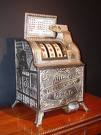
| Games of chance have been in existence for centuries. While the exact origins of many of today’s casino games are unknown, we do know that the most popular and profitable gaming device was invented in the United States. |
| Games of chance have been in existence for centuries. While the exact origins of many of today’s casino games are unknown, we do know that the most popular and profitable gaming device was invented in the United States. It is the slot machine and it was invented in 1887 by Charles Fey in San Francisco. Prior to Fey’s invention there were other coin operated games of chance. Most of these were poker machines that allowed a player to win a cigar or free drinks when they lined up a winning combination. Since the winners were paid in some sort of merchandise the name “trade stimulator” was attached to these types of machines. Coin Payouts What set Fey’s machine apart from the other trade stimulators is that his machine was the first machine designed to pay out in coins. His slot machine had three reels and each reel had ten symbols printed on it. The symbols were horseshoes, spades, diamonds, hearts and bells. Lining up three bells would win the top prize. This machine would come to be known as a “Bell” machine. According to the book, Slot Machine Mania, an article appeared in the San Francisco chronicle on April 15th 1887 reporting that a group of saloon and restaurant owners had gathered to watch Fey demonstrate his new Liberty Bell slot machine. The machine was activated when a player inserted a coin into a slot and then pulled a handle, or arm, to start the wheels spinning. The owners were impressed and everyone present predicted that the machine would be a success. One hundred years later, that prediction can be considered somewhat of an understatement. Fey’s design of a machine with three spinning wheels became the standard that future slot machines would be based upon. Unfortunately for Fey, patent laws of the time did not protect gaming devices. Because of this, Fey did not sell his machines instead he placed them in gambling saloons and other locations and collected a 50 percent rental fee on all the winnings. Limited Jackpots The jackpot was limited on the early slot machines. Since the machine had three reels with ten symbols on each reel there were 1,000 combinations that could be made. (10x10x10= 1,000.) The total payout for all of the different winning combinations was 750 coins. This gave the “House” a 25 percent profit. It is interesting to note that on Fey’s machines the pay table listed drinks as the prizes, when in reality the machine actually paid out coins. This was a way to get around gaming laws. Later models of slot machines would dispense mints or gum with each spin as another way to get by gaming laws. A Winning Partnership In 1907 Fey teamed up with Herbert Mills who owned the Mills Novelty company. In 1910 the Mills company introduced the “Operators Bell” machine that had three reels with 20 different symbols on each reel. The machine also featured a “gooseneck” coin entry and the symbols on the machines were replaced with fruit symbols as well as the bells for the jackpot. These machines weighed over 100 pounds. The Mills company manufactured 30,000 of these machines. The popularity of slot machines spread across the United States even though they were not legal in many States. In 1940 Bugsy Siegal put the slot machines on the floor of his Flamingo casino in Las Vegas. At first the slot machines were installed as a diversion for the wives and girlfriends of the table game players. Modern technology would change that and today the slot machine accounts for about 80 percent of the casino’s profits. It is doubtful that Charles Fey ever imagined the legacy he was leaving when he invented his first slot machine but his little invention changed the face of gambling forever. |










